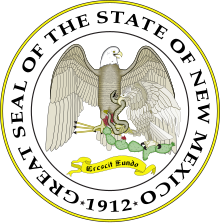| Constitution of the State of New Mexico | |
|---|---|
 | |
| Overview | |
| Jurisdiction | New Mexico |
| Subordinate to | Constitution of the United States |
| Created | November 21, 1910 |
| Ratified | January 21, 1911 |
| Date effective | January 6, 1912 |
| System | Single executive |
| Government structure | |
| Branches | 3 |
| Chambers | Two (New Mexico Legislature): New Mexico Senate New Mexico House of Representatives |
| Executive | Governor of New Mexico |
| Judiciary | Supreme, Appeals, Trial |
The Constitution of the State of New Mexico (Spanish: Constitución del Estado de Nuevo México) is the document that establishes the fundamental political framework of the U.S. state of New Mexico. It sets forth the principles and structure of government, enumerates the rights of citizens, and functions as the supreme law of the state, subordinate only to the United States Constitution.
New Mexico held its first constitutional convention in 1850, two years after being annexed as a territory of the U.S.[1] Over the next sixty years, it produced four constitutions,[2] of which the current document was drafted by the Constitutional Convention of 1910; the resulting draft was adopted by referendum in both English and Spanish,[3] ratified by popular vote on January 21, 1911, and became effective on January 7, 1912 upon admission to the union.[1]
The New Mexico Constitution is unique in the U.S. for recognizing the state's cultural and ethnic diversity;[4] it reaffirms the rights of Hispanos and Spanish speakers under the Treaty of Guadalupe Hidalgo, which granted U.S. citizenship and various legal protections to former Mexican nationals, and prohibits discrimination based on an "inability to speak, read or write the English or Spanish languages."[3]
The New Mexico Constitution has 24 Articles and has been amended more than 170 times;[5] by comparison, the U.S. Constitution has seven Articles and 27 amendments after over 230 years.[6] Amendments may be proposed by a majority vote of each house of the legislature and must then be submitted to the voters of the state for approval. An attempt to adopt a new constitution narrowly failed by referendum in 1969.
As in other states, New Mexicans are granted broader rights than the federal constitution, including more expansive protections to free speech, firearm ownership, and due process, a right to free public school, and freedom from sex-based discrimination.[7]
- ^ a b Cite error: The named reference
:0was invoked but never defined (see the help page). - ^ Donnelly, Thomas C. "The Making of the New Mexico Constitution Part I." New Mexico Quarterly 11, 4 (1941).
- ^ a b Baker, Deborah (2013-06-09). "Spanish not 'enshrined' as official N.M. language". Albuquerque Journal. p. B1. Retrieved 2023-05-01 – via Newspapers.com.
- ^ Lux, Dr Guillermo (2023-06-01). "The New Mexico Constitution". Race, Racism and the Law. Retrieved 2023-06-01.
- ^ As of 2021
- ^ "New Mexico Constitutional History – Constituting America". constitutingamerica.org. Retrieved 2023-04-28.
- ^ Constitution Comparison Chart New Mexico General Services Department.